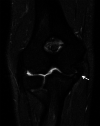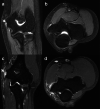Radiographic and MRI Assessment of the Thrower's Elbow
- PMID: 33864627
- PMCID: PMC8137781
- DOI: 10.1007/s12178-021-09702-x
Radiographic and MRI Assessment of the Thrower's Elbow
Abstract
Purpose of review: Throwing athletes are vulnerable to elbow injuries, especially in the medial elbow, related to high stress and valgus load in both acute and chronic settings as a result of this complex biomechanical action. This current review details the relevant anatomy and imaging features of common elbow pathology identified with radiographs and MRI in throwing athletes.
Recent findings: Although elbow pathology in throwing athletes is well documented, advances in imaging technology and technique, particularly with MRI, have allowed for more detailed and accurate imaging description and diagnosis. Pathology of thrower's elbow occurs in predictable patterns and can be reliably identified radiologically. Clinical history and physical examination should guide radiologic evaluation initially with radiographs and followed by an MRI optimized to the clinical question. Constellation of clinical, physical, and radiologic assessments should be used to guide management.
Keywords: Elbow; MRI; Overhead throwing athlete; Thrower’s elbow.
Conflict of interest statement
Garret Powell, Naveen Murthy, and Adam Johnson declare that they have no conflict of interest.
Figures











Similar articles
-
The thrower's elbow.Orthop Clin North Am. 2014 Jul;45(3):355-76. doi: 10.1016/j.ocl.2014.03.007. Orthop Clin North Am. 2014. PMID: 24975763
-
Elbow arthroscopy: treatment of the thrower's elbow.Instr Course Lect. 2006;55:95-107. Instr Course Lect. 2006. PMID: 16958443 Review.
-
The thrower's elbow: arthroscopic treatment of valgus extension overload syndrome.HSS J. 2006 Feb;2(1):83-93. doi: 10.1007/s11420-005-5124-6. HSS J. 2006. PMID: 18751853 Free PMC article.
-
Diagnosis and Treatment of Posteromedial Elbow Impingement in the Throwing Athlete.Curr Rev Musculoskelet Med. 2022 Dec;15(6):513-520. doi: 10.1007/s12178-022-09789-w. Epub 2022 Aug 25. Curr Rev Musculoskelet Med. 2022. PMID: 36006592 Free PMC article. Review.
-
Adaptive pathology: new insights into the physical examination and imaging of the thrower's shoulder and elbow.J Shoulder Elbow Surg. 2024 Feb;33(2):474-493. doi: 10.1016/j.jse.2023.07.031. Epub 2023 Aug 29. J Shoulder Elbow Surg. 2024. PMID: 37652215 Review.
Cited by
-
The Prevalence of Shoulder and Elbow Pathology in Major League Baseball Prospects From the Dominican Republic.Sports Health. 2025 Jul;17(4):766-774. doi: 10.1177/19417381241277790. Epub 2024 Sep 5. Sports Health. 2025. PMID: 39238176 Free PMC article.
-
Osteochondritis Dissecans of the Elbow in Overhead Athletes: A Comprehensive Narrative Review.Diagnostics (Basel). 2024 Apr 28;14(9):916. doi: 10.3390/diagnostics14090916. Diagnostics (Basel). 2024. PMID: 38732330 Free PMC article. Review.
References
-
- Meister K. Injuries to the shoulder in the throwing athlete. Part one: biomechanics/pathophysiology/classification of injury. Am J Sports Med. 2000;28(2):265–275. - PubMed
-
- Kijowski R, Tuite M, Sanford M. Magnetic resonance imaging of the elbow. Part II: abnormalities of the ligaments, tendons, and nerves. Skelet Radiol. 2004;34(1):1–18. - PubMed
-
- Richard MJ. Traumatic valgus instability of the elbow: pathoanatomy and results of direct repair. J Bone Joint Surg Am. 2008;90(11):2416–2422. - PubMed
-
- Potter HG, Ho ST, Altchek DW. Magnetic resonance imaging of the elbow. Semin Musculoskelet Radiol. 2004;8(1):5–16. - PubMed
Publication types
LinkOut - more resources
Full Text Sources
Other Literature Sources
Research Materials

